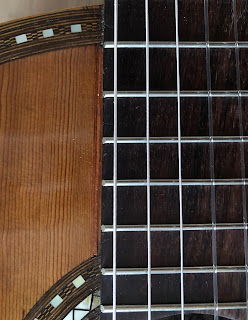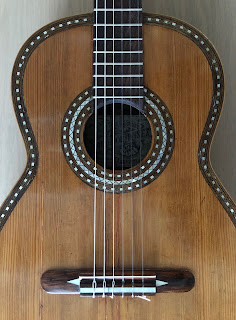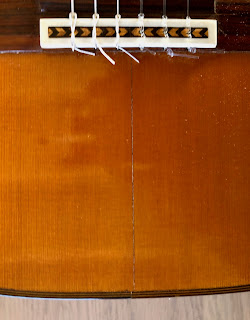Jaime Ribot / Salvador Ibanez 1908
I'd like to start with the end result: The guitar as it is now.
Great bonus was the awesome tone! Scale: 650 mm. Width
at topnut: 52 mm.Width at the bridgebone: 54 mm. SOLD
A newly added label. I'll explain this decision
further in my explanation.
The back that has been French polished as is the rest of
this guitar.
Only two small inserts in the centre of the bottom
were needed. Hardly detectable now.
As there were too much loose braces and other damages
I decided to open the guitar in order to be able to repair
all those imperfections in a better way.
As the back had to be taken off a new binding of course.
The soundboard, still absolutely straight before
and behind the newly glued bridge.
Half of the original frets were missing so a new fret job
was necessary. Also to change the angle neck to body.
Some mother of pearl pieces were missing. Newly added
of course. The two triangular inlays on both sides of the
bridge are not in line. Remarkable but I've seen this more
on Salvador Ibanez guitars!
The head with its' inlays. Again in a like new condition.
No damages to the back of the head. Not any cracks
here. Original tuners as well.
The typical Valencian way of building a heel.
In fact photographed to show the action. This guitar
is very comfortably playable now with its' 4 mm action
on the 6th string (twelfth fret) and 3 mm on the first.
Maybe even lower for the first string. A joy to play!
Just a nice shot but also to show the inserts alongside
the left and right side of the fingerboard as this often
occurs on older guitars.
A Brasilian rosewood fingerboard as opposed to the later
used ebony on their highest models when Salvador Ibanez
e Hijos were in charge.
All the repaired cracks can be seen here. I've left the
inserts just a bit higher so a luthier very experienced
in coloring the insert might do a better job.
The bridge already was partly loose and having seen the knob
for a strap (I do not know wether if this is original?) and
the holes for a string holder I presume someone putted on
a set of metal strings!
A beautiful rosette but in fact carved a bit too deep in
the soundboard. Therefore I strengthened the inner part
of the sound hole to prevent any future damages. That
can be removed but is not advisable.
I took the opportunity to remove the bridge a bit further
away from the sound hole to ensure a perfect octave pitch!
The knob for the G-string is a bit bowed but works perfectly.
Dangerous to have it placed back in the "start" position so I
left it that way as it works normally.
The guitar in question in unrestored condition.
A body close up with the frets already removed.
Similarities with a Jaime Ribot guitar. But also with a Francisco
Pau guitar. It would have been easy to place a label in this guitar
from these luthiers but to be honest: Everything points towards
Salvador Ibanez as I already explained here and there.
The Jaime Ribot guitar and other builders appear to
have similar ornamentations as on guitars of some other
Valencian makers they can be seen: Francesco Pau
and of course Salvador Ibanez.
The Jaime Ribot label, a bit damaged.
Again, but now with the strings in between. You can easily
make pictures with your mobile telephone by simply sliding
your telephone below the strings and then make a picture.
These pictures are NOT from the guitar in question!
The guitar presented with the bridge off as it was
easy to remove it. It was already partly loose.
The body before the crack repairings took place.
The label that should have been in this guitar. Photographed
and shopped to make it clearer thus giving more details.
This label must have been used between 1905 - 1910.
Some reparations (inserts) were needed and therefore
the back has to be French polished from the start.
A knob at the bottom intended for use with a holding
strap. Wether if this is original can be discussed of course.
The holes a bit higher placed are the traces of a formerly
placed tailpiece, probably for metal strings...
Strange is the unevenness of the inlays on both sides of the
string tie block. I've noticed it on other guitars from Ibanez
guitars of that period. The inserts necessary can be studied
here. More easy to do that without the bridge glued on.
The head and the newly placed frets as half of them were
already missing and moreover, I had to make a neck to
body angle correction. For that purpose I shaved away
material of the fingerboard towards the head.
I've shortened the headstock with about 1 mm in order
to get rid of disturbing damages that occur when placing
a guitar frequently with its' head against a wall.
A new quality topnut that has to be
there on a concert guitar of this age.
Though the back has been taken off, a picture with the
label sticked in from the sound hole has to be there.
This happens so often! In this case the two transverse braces
were partly loose and then string tension can cause these
problems much easier. To prevent this in the future I placed
an extra wide but thin layer between the two transverse bars
in the upper bout. The Japanese do this often to prevent
these damages.
Another move was to strengthen the soundhole
edges as when the space for a rosette is carved too
deep it severely weakens that spot. The cleat
beyond has been placed at the end of a crack.
Every single glue block that attach the soundboard to
the sides must be checked and reglued if necessary. The
transverse bars above the sound hole had to be reglued.
But they are the original ones.
And the same insert on the other side.
A knob at the borttom intended for use with a holding
strap. Wether if this is original can be discussed of course.
The holes a bit higher placed are the traces of a formerly
placed tailpiece, probably for metal strings...
No spruce heel operation on this guitar, often done by
Valencian makers to speed up production processes.
And a picture of the other side of course.
The new added bindings around the back.
New proper fretwork.
A nice shot of the ornamentation and the Brazilian
rosewood fingerboard used here.
The insert on the right can be studied here.
Inserts coloured a bit better...
The beautiful rosette with some newly placed
pieces of pearl inlay.
The sides that are in pristine condition.





































































